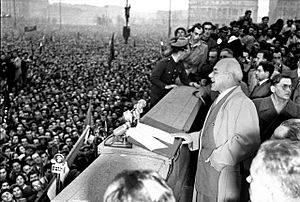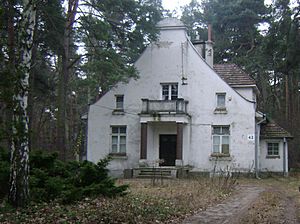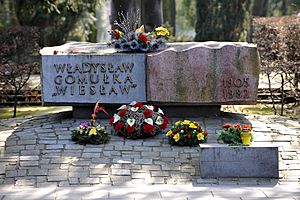Władysław Gomułka facts for kids
Quick facts for kids
Władysław Gomułka
|
|
|---|---|
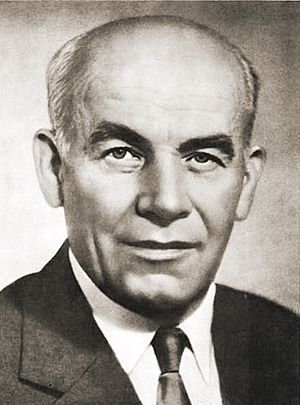
Gomułka in 1960
|
|
| First Secretary of the Polish United Workers' Party | |
| In office 21 October 1956 – 20 December 1970 |
|
| Prime Minister | Józef Cyrankiewicz |
| Chairman | Aleksander Zawadzki Edward Ochab Marian Spychalski |
| Preceded by | Edward Ochab |
| Succeeded by | Edward Gierek |
| First Secretary of the Polish Workers' Party | |
| In office 23 November 1943 – 3 September 1948 |
|
| Preceded by | Paweł Finder |
| Succeeded by | Bolesław Bierut |
| Personal details | |
| Born | 6 February 1905 Krosno, Austria-Hungary (now Poland) |
| Died | 1 September 1982 (aged 77) Konstancin, Poland |
| Resting place | Powązki Military Cemetery, Warsaw |
| Nationality | Polish |
| Political party |
|
| Spouse | Liwa (Zofia) née Szoken (1902–1986) |
Władysław Gomułka (born February 6, 1905 – died September 1, 1982) was a Polish politician. He was a leader of Poland after World War II. From 1947 to 1948, he was the de facto (actual) leader of the Polish People's Republic.
After a period away from power, he became leader again from 1956 to 1970. Gomułka was first very popular because he wanted to make changes. He aimed for a "Polish way to socialism". This time was known as the "Polish thaw" because things became less strict.
However, in the 1960s, he became more rigid. He was afraid of upsetting the system. He did not want to make or allow new changes. During this time, he supported actions against the Catholic Church, smart people, and those who disagreed with the government.
In 1967 and 1968, Gomułka allowed a political campaign. This campaign was used to keep him in power. It shifted attention away from the struggling economy. Many Polish Jews left the country during this time. He was also responsible for stopping student protests and making media censorship stricter. Gomułka supported Poland joining the Warsaw Pact invasion of Czechoslovakia in August 1968.
In December 1970, a treaty was signed with West Germany. This treaty recognized Poland's borders after World War II. This helped create peace and stability in Central Europe. In the same month, economic problems led to price increases. This caused protests by workers on the Baltic coast. Several workers were killed. These sad events led to Gomułka's resignation. Edward Gierek took over as the Party leader, and tensions calmed down.
Contents
Early Life and School
Władysław Gomułka was born on February 6, 1905. He was born in a village called Białobrzegi Franciszkańskie. This village was near Krosno, in a part of Poland controlled by Austria. His parents were workers. They had met and married in the United States. They went there to find work in the late 1800s. But they returned to Poland in the early 1900s. This was because Władysław's father, Jan, could not find good work in America.
Jan Gomułka then worked in the oil industry. Władysław's older sister, Józefa, was born in the US. She returned there when she turned eighteen. She wanted to join her family and keep her US citizenship. Władysław and his two other siblings grew up very poor. They lived in a broken-down hut and mostly ate potatoes. Władysław only had basic schooling. He started working in the oil industry when he was young.
Gomułka went to school in Krosno for about six or seven years. He stopped at age thirteen. Then he started an apprenticeship in a metalworks shop. Gomułka loved to read his whole life. He taught himself a lot. But people sometimes made jokes about his lack of formal education. In 1922, Gomułka passed his apprenticeship exams. He then started working at a local refinery.
First Steps in Politics
Joining Worker Groups and First Arrest
When Gomułka was a teenager, Poland was a new country. There were many strong political disagreements. The young worker became involved with radical groups. He joined the Siła (Power) youth group in 1922. In 1925, he joined the Independent Peasant Party. Gomułka was known for being active in metal workers' unions. From 1922, he also worked with chemical industry unions.
He took part in union strikes. In 1924, he debated with Herman Lieberman at a protest in Krosno. He wrote strong articles in leftist newspapers. In May 1926, Gomułka was arrested for the first time. But he was soon released because workers demanded it. In October 1926, Gomułka became a secretary for a chemical workers' union. He stayed with this union, which was led by communists, until 1930. Around this time, he also learned basic Ukrainian.
In late 1926, Gomułka joined the Communist Party of Poland (KPP). This party was illegal but still active. He was arrested for political actions. He was mainly interested in social issues. These included trade and worker movements. He focused on practical work. In mid-1927, Gomułka moved to Warsaw. He was active there until he had to join the military at the end of the year. After a few months, the military let him go due to a leg problem. Gomułka went back to communist party work. He organized strikes and spoke at worker meetings across Poland. During this time, he was arrested several times and watched by the police.
Gomułka was active in leftist worker unions from 1926. He also worked for the KPP's Central Trade Department from 1931. In the summer of 1930, Gomułka traveled abroad illegally. He wanted to go to a worker union meeting in Moscow. He traveled through Germany to get Soviet documents. He arrived in Moscow too late for the meeting. He stayed in Moscow for a few weeks. Then he went to Leningrad (now Saint Petersburg). From there, he took a ship to Hamburg. He stayed in Berlin again and returned to Poland.
In August 1932, police arrested him in Łódź. He was at a meeting of textile worker representatives. When he tried to escape, Gomułka was shot in his left leg. This injury made it hard for him to walk for the rest of his life.
Travel to the Soviet Union and Second Arrest
On June 1, 1933, Gomułka was sentenced to four years in prison. But he was let out temporarily in March 1934 for leg surgery. After his release, Gomułka asked the KPP to send him to the Soviet Union. He needed medical treatment and more political training. He arrived in the Soviet Union in June. He went to the Crimea for several weeks for therapy.
Gomułka then spent over a year in Moscow. He attended the Lenin School under the name Stefan Kowalski. The classes focused on ideas. A small group of Polish students had separate classes. They also had military training. The school described Gomułka in very good ways. But his long stay in the Soviet Union made him feel disappointed. He saw the problems of communism under Stalin. He became very critical of forced farming. In November 1935, he returned to Poland secretly.
Gomułka continued his communist and labor activities. He moved up in the KPP organization. He became the secretary of the Party's Silesian branch. In April 1936, he was arrested in Chorzów. He was then tried in Katowice and sentenced to seven years in prison. He stayed in jail until World War II began. This imprisonment likely saved his life. Most of the KPP leaders were killed in the Soviet Union in the late 1930s. They were caught in the Great Purge under Joseph Stalin.
Gomułka's experiences made him very suspicious. He believed that Poland under the Sanation government was a fascist state. But he also felt positive about the country and its people, especially workers.
World War II
War Begins in Poland
When the war with Nazi Germany started, Gomułka was freed from prison. On September 7, 1939, he arrived in Warsaw. He stayed there for a few weeks. He helped build defenses in the city, which was under attack. Like many other Polish communists, Gomułka fled to eastern Poland. The Soviet Union invaded this area on September 17, 1939. In Białystok, he ran a home for former political prisoners.
At the end of 1939, Gomułka moved to Lviv. This area was controlled by the Soviets. He was reunited with his wife there. Like other members of the old Communist Party of Poland, Gomułka wanted to join the Soviet Communist Party. The Soviet authorities allowed this only from March 1941. In April of that year, Gomułka received his party card in Kiev.
Life for Polish communists changed greatly after 1941. Germany attacked Soviet positions in eastern Poland. The Gomułkas were very poor in Lviv, which was now occupied by Germany. By the end of 1941, they managed to join Władysław's family in Krosno. But an important event happened for communist politics. In January 1942, Joseph Stalin restarted a Polish communist party in Warsaw. It was called the Polish Workers' Party (PPR).
In 1942, Gomułka helped restart a Polish communist party. The old KPP was destroyed in Stalin's purges. The new party was called the Polish Workers' Party (PPR). Gomułka helped create party groups in the Subcarpathian region. He started using his wartime secret name, "Wiesław." In July 1942, Paweł Finder brought Gomułka to Warsaw. In August, the secretary of the PPR's Warsaw Committee was arrested. "Wiesław" took over his job. In September, Gomułka joined the PPR's Temporary Central Committee.
In late 1942 and early 1943, the PPR faced a big problem. Its first secretary, Marceli Nowotko, was murdered. Gomułka helped investigate another leader, Bolesław Mołojec. This led to Mołojec's execution. In January 1943, Gomułka (as "Wiesław") joined the Party's new main leadership. This group included Paweł Finder, who became the First Secretary, and Franciszek Jóźwiak. In the next months, the Central Committee grew to include Bolesław Bierut.
In February 1943, Gomułka led the communist side in important meetings. These meetings were in Warsaw. They were between the PPR and the Polish government-in-exile in London. They also met with the Home Army. The talks did not work out. This was because the groups had different goals and did not trust each other. The London government stopped the talks on April 28. This was three days after the Soviet government broke ties with the Polish government. Gomułka became the Party's main thinker. He wrote a publication called "What do we fight for?" in March 1943. He also wrote a longer version in November. "Wiesław" oversaw the Party's main writing and publishing work.
Gomułka tried to get other political groups in Poland to work with the PPR. But he was mostly unsuccessful. Bierut, however, did not care about these attempts. He just counted on the Red Army to help the communists take power in Poland later. These different plans caused a big conflict between the two communist politicians.
New Polish Government Bodies
In late 1943, the PPR leaders started talking about creating a Polish body. It would be like a parliament, led by communists. It would be called the State National Council (KRN). After the Battle of Kursk, people expected a Soviet victory. They thought Poland would be freed. The PPR wanted to be ready to take power. Gomułka came up with the idea of a national council. He convinced the other leaders to agree. The PPR wanted to get approval from the Soviet leader, Georgi Dimitrov.
However, in November, the Gestapo arrested Finder and Małgorzata Fornalska. They had the secret codes to talk with Moscow. So, the Soviet answer was unknown. Without Finder, Gomułka was chosen as the general secretary (chief) of the PPR on November 23. Bierut joined the three-person leadership group.
The first meeting of the State National Council happened on December 31, 1943. Bierut, the new chairman, became Gomułka's main rival. In mid-January 1944, Dimitrov finally learned about the KRN. This surprised him and the Polish communist leaders in Moscow. These leaders, led by Jakub Berman, had different ideas for a Polish communist party and government.
Gomułka felt that Polish communists in Poland understood Polish life better. He thought the State National Council should decide how Poland's future government would look. Still, to get Soviet approval, a KRN group left Warsaw in mid-March for Moscow. They arrived two months later. By then, Stalin decided the KRN was a good idea. He and other Soviet leaders welcomed the Poles from Warsaw. The Polish communists in Moscow were pressured to accept the PPR, the KRN, and Władysław Gomułka as leaders. They finally did so in mid-July.
On July 20, Soviet forces crossed the Bug River. On the same day, Polish communists from Moscow and Warsaw met. They finished plans for the Polish Committee of National Liberation (PKWN). This was a temporary government. It was led by Edward Osóbka-Morawski, a socialist allied with the communists. Gomułka and other PPR leaders left Warsaw. They went to Soviet-controlled territory. They arrived in Lublin on August 1. This was the day the Warsaw Uprising began in the Polish capital.
After the War
Taking Power in Poland
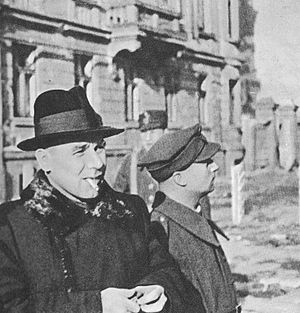
Gomułka was a deputy prime minister. He served in the Provisional Government of Poland from January to June 1945. He also served in the Provisional Government of National Unity from 1945 to 1947. He was a minister for the Recovered Territories (1945–48). He had a big impact on rebuilding Poland within its new borders. He oversaw the settlement and development of lands gained from Germany.
Using his position, Gomułka led changes in Poland. He helped crush resistance to communist rule after the war. He also helped the communists win the "Three Times Yes" referendum in 1946. A year later, he was key in the 1947 elections. These elections were set up to give communists a big win. After the elections, all other legal opposition in Poland was stopped. Gomułka was then the most powerful man in Poland. In June 1948, Gomułka spoke about the history of the Polish worker movement. This was before the PPR and PPS parties joined.
In 1948, Gomułka wrote a note to Stalin. He said that "some of the Jewish comrades don't feel any link to the Polish nation or to the Polish working class." He thought it was important to slowly lower the number of Jewish people in government and party jobs.
Stepping Away from Politics
In the late 1940s, Poland's communist government had a rivalry. It was between Gomułka and President Bolesław Bierut. Gomułka led a group that focused on Poland. Bierut led a group trained by Stalin in the Soviet Union. This struggle led to Gomułka being removed from power in 1948. Bierut wanted to follow Moscow completely. Gomułka wanted to change the communist plan for Poland. He was against forced collectivization of farms. He also doubted the Cominform.
The Bierut group had Stalin's support. Stalin ordered Gomułka to be removed as party leader. He was accused of being a "rightist-nationalist." Bierut replaced him. In December, the PPR and Polish Socialist Party joined. They formed the Polish United Workers' Party (PZPR). Gomułka was removed from this new party's Politburo. In January 1949, he lost his remaining government jobs. In November, he was kicked out of the party completely. For the next eight years, he held no official jobs. He was also persecuted, including almost four years in prison from 1951 to 1954.
Bierut died in March 1956. This was during a time when Poland was moving away from Stalin's strict rules. Edward Ochab became the new first secretary of the Party. Soon after, Gomułka was partly cleared. Ochab said Gomułka should not have been jailed. But he still repeated the old charges against him.
Return to Power
In June 1956, strong worker protests happened in Poznań. The government harshly stopped these protests. Dozens of workers were killed. But the Party leaders, including many who wanted reforms, understood some of the workers' demands. They took steps to calm the workers.
Reformers in the Party wanted Gomułka to return to leadership. Gomułka insisted he be given real power to make more changes. He wanted some Party leaders replaced. This included the pro-Soviet Minister of Defense, Konstantin Rokossovsky.
The Soviet leaders were worried about events in Poland. Soviet troops moved deeper into Poland. At the same time, a high-level Soviet group flew to Warsaw. It was led by Nikita Khrushchev. Ochab and Gomułka made it clear that Polish forces would fight if Soviet troops advanced. But they told the Soviets that the changes were internal. They said Poland would not leave the communist group or its agreements with the Soviet Union. The Soviets agreed.
Most of the Politburo members wanted Gomułka back. First Secretary Ochab agreed. On October 20, the Central Committee brought Gomułka and some friends into the Politburo. They removed others. Gomułka was elected as the first secretary of the Party. Gomułka, who had been a prisoner of the Stalinists, was very popular across the country. People showed their support in a huge street protest in Warsaw on October 24. Khrushchev saw that Gomułka was popular. He also heard Gomułka say he wanted to keep the alliance with the Soviet Union. So, Khrushchev decided that Gomułka was a leader Moscow could accept.
Leading Poland
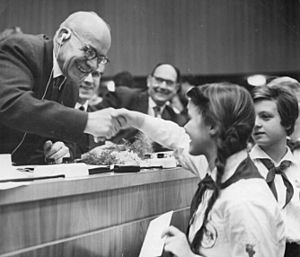
Working with Other Countries
A big concern for Gomułka was the Oder-Neisse line. This was Poland's western border after World War II. West Germany did not want to recognize this border. Gomułka knew that Poland's border was not secure. He felt threatened by statements from the West German government. He believed that the alliance with the Soviet Union was the only thing stopping a future German invasion.
The new Party leader said in October 1956: "Poland needs friendship with the Soviet Union more than the Soviet Union needs friendship with Poland... Without the Soviet Union we cannot maintain our borders with the West." A treaty with West Germany was discussed and signed in December 1970. Germany recognized the post-World War II borders. This created a base for future peace and cooperation in Central Europe.
During the Prague Spring in Czechoslovakia, Gomułka was a key leader of the Warsaw Pact. He supported Poland joining the invasion of Czechoslovakia in August 1968.
Policies at Home
In 1967–68, Gomułka allowed a political campaign. This started because the Soviet bloc was unhappy with the outcome of the Arab-Israeli Six-Day War. This campaign was used by Gomułka to stay in power. It shifted people's attention from the struggling economy. This led to many Polish citizens of Jewish origin leaving the country. At that time, he was also responsible for stopping student protests. He also made censorship of the media stricter.
Leaving Office
In December 1970, economic problems caused prices to rise. This led to protests. Gomułka ordered the army to shoot at striking workers in Gdańsk and Gdynia. Over 41 shipyard workers were killed. More than a thousand people were hurt. These tragic events forced Gomułka to resign and retire. Edward Gierek took over as Party leader, and tensions eased.
After he was removed, Gomułka's image in government messages slowly changed. Some of his positive contributions were recognized. He is seen as an honest person who believed in the socialist system. He could not solve Poland's big problems. He also could not meet different demands. Later in his career, he became more rigid and strict. He was a heavy smoker. He died in 1982 at age 77 from lung cancer. Gomułka's memoirs were published in 1994, long after his death. This was five years after the communist government he served fell.
An American journalist, John Gunther, described Gomułka in 1961. He said Gomułka was "like a professor, distant, and sharp, with a unique lively energy." Gomułka was buried at Powązki Military Cemetery in Warsaw.
Awards and Honors
- Other countries:
 Grand Cross of the Legion of Honour (France)
Grand Cross of the Legion of Honour (France) Knight Grand Cross with Collar of the Order of Merit of the Italian Republic (Italy)
Knight Grand Cross with Collar of the Order of Merit of the Italian Republic (Italy) Order of Lenin (Soviet Union)
Order of Lenin (Soviet Union) Jubilee Medal "In Commemoration of the 100th Anniversary of the Birth of Vladimir Ilyich Lenin" (Soviet Union)
Jubilee Medal "In Commemoration of the 100th Anniversary of the Birth of Vladimir Ilyich Lenin" (Soviet Union)
See also
 In Spanish: Władysław Gomułka para niños
In Spanish: Władysław Gomułka para niños


